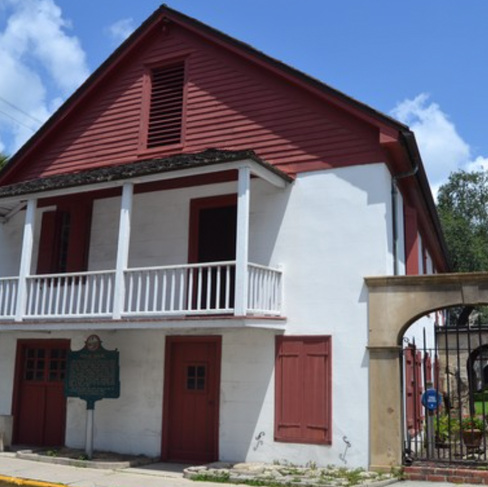One day in St. Augustine, the oldest city in the United States
- Maria Palomino
- 7 jun 2022
- 3 Min. de lectura
Actualizado: 9 mar 2023

The oldest city in the United States has colonial architecture and a history that links it to Spain and its origins. Its baroque-style old town and old-world style will transport you for a few moments to another era. It is also surrounded by a particularly romantic atmosphere, making it a place of authentic fairy tale. The city combines Spanish Renaissance facades with historic Victorian houses.
St Augustine's History
On April 2, 1513, Ponce de León landed somewhere on the east coast of the United States, and named this new land "La Florida", and claimed it for Spain. Many historians believe he made landfall in St. Augustine, although there are other places further south that may also be the landing site, such as "Melbourne Beach" and "Ponce de Leon Inlet".
Other Spanish explorers later found gold and silver in Mexico and Peru, and several Spanish settlements were established in Florida to protect the fleets that transported the treasure back to Spain by ship on the gulf currents.
King Felipe II of Spain sent Pedro Menéndez de Avilés to settle in Florida, and to drive out the French troops recently established there, and in September 1565, along with 700 soldiers and settlers, he founded St. Augustine, making it the oldest continuously occupied European settlement in North America.
Menéndez successfully destroyed the French fort "Caroline" at the mouth of the St. Johns River, 40 miles north of St. Augustine, and ended the French incursion into Florida.
The early settlers of St. Augustine, isolated and often plagued by starvation, lived in constant fear of pirate attacks that roamed the coast, which together with the growing hostility of the Native Americans, made life quite difficult .
Francis Drake burned the town and the wooden fort in 1586. The town was sacked again in 1668 by the pirate John Davis.
The Queen Regent of Spain, Mariana, realized that St. Augustine was key to the defense of the Florida coast, so she ordered the construction of a new stone fort. In 1672, construction began on Castillo de San Marcos, which took 23 years to complete.
In 1702, seven years after its completion, English troops from South Carolina laid siege to the castle for fifty days. Fifteen hundred Spanish citizens refused to surrender, and the British finally abandoned and burned the city - This event is the reason there are no buildings older than 1702 in St. Augustine. The Spanish rebuilt their settlement, and fortified the walls around the town and castle.
The English attacked again in 1740, this time led by General James Oglethorpe of Georgia (founder of Savannah), who bombarded the castle and town for twenty-seven days, before he also surrendered and left.
England defeated Spain in the Seven Years' War, and Florida was transferred to English control by the Treaty of Paris in 1763. England divided Florida into two colonies, and St. Augustine became the capital of East Florida.
During the American Revolution, St. Augustine remained loyal to the crown. The entire Florida peninsula was returned to Spain as part of the negotiations that ended the Revolutionary War in 1783. The Spanish returned to an impossible situation. The frontier problems of earlier times, multiplied as runaway slaves from Georgia were welcomed among the Seminole Indians, and land and sea ruffians made Florida their habitat. Spain ruled for another 37 years (Second Spanish Period 1783-1821). During this time, the Spanish had difficulty attracting settlers to repopulate this area.
On July 10, 1821, the Americans took over from the Spanish. In 1845, Florida became the 27th state of the Union.
What to see in St Augustine
Visitor centre
The St. Augustine Visitor Information Center is the ideal place to start your visit to the city, as it has plenty of free brochures and maps, and we found the staff to be super friendly. Inside you will also find restrooms, a gift store, and even a local exhibit, which changes regularly.
Very close to the visitor center, and easily visible from the street, is the public cemetery. During the yellow fever epidemic of 1821, this field was reserved for the burial of non-Catholic citizens. Many Protestant pioneers of the new Florida territory are buried here.
Old city gate
The pillars of the old city gate, still standing today, along with reconstructed parts of the cube line, mark the beginning of "St. George Street", the heart of the city.
George street
St. Augustine's old main street, St. George, is surrounded by beautiful century-old buildings, and has a wonderful mix of old-world charm and cosmopolitan flair. This beautiful cobblestone street is home to one of the city's most popular shopping districts. Along the pedestrian portion of the boulevard between Orange Street and Cathedral Place, you'll find galleries and boutiques in historic buildings.
Oldest wooden school house
The oldest wooden school in St. Augustine was built with red cedar and cypress and is now a historical museum. The building is about 200 years old.

Plaza de la constitución (Constitution Square)
In the heart of downtown is the oldest public park in the United States. It was created in 1573 by order of the King of Spain. Public buildings surrounded the plaza in the Spanish period, and some still stand today. The name of the square refers to the short-lived Spanish Constitution of 1812, not to that of the United States.
Next to the square you will find St. Augustine Cathedral, the first Catholic parish in the USA.

Government's house
The government building dates back to 1598, and has served as a residence, courthouse, administrative headquarters and post office. Today, it is maintained by the University of Florida as a public museum.
Avilés street
The oldest street in the historic center, with its cobblestones, historic houses and the Colonial Military Hospital. Lots of history here.
Spanish colonists originally named the street "Hospital Street" because there was a colonial military hospital located along the street. The name was later changed to honor the Spanish hometown of the city's founder. This former hospital, located on Avilés Street, treated military personnel during the periods when Spain and Great Britain ruled St. Augustine.
Oldest House
The Gonzalez-Alvarez House is the oldest house still standing from the Spanish colonial period in St. Augustine. It dates from the early 1700s.
The original structure was very simple and was built with coquina, a sediment formed by ancient sea shells.
Lightner museum
The current museum is located in the former "Hotel Alcazar", an elegant complex from the golden age of St. Augustine. Built in 1887 by Henry Flagler, this imposing Spanish Renaissance-style building, designed by architects Carrère & Hastings, is a must-see.
Flager college
The magnificent structure Flagler College was once the Ponce De Leon Hotel. Built between 1885 and 1887 by railroad magnate Henry Flagler, the luxury hotel served guests in St. Augustine until the 1960s, when it was acquired by Flagler College.
It is worth going inside to see the lobby and the courtyard, which is completely free of charge.
San Marcos Fort
San Marcos fort, is one of the best places to enjoy the essence of the city. Despite its more than 300 years of history, the building is in a good state of preservation. It has been declared a national monument. It can be visited every day from 9 am to 5 pm. Admission is $15 for adults and free for children.
The lighthouse of St Augustine
The lighthouse is another of the most visited sites. It has its origins in the late nineteenth century, specifically in 1874. The entrance fee is 13 dollars. One of the most curious things about this construction is that it is relatively far from the coast, its location was chosen to increase its visibility by being on top of a dune.
Still have some time and want to visit something else? I've got you covered:
Fort Matanzas
Fort Matanzas National Monument is one of the Florida Bucket List stops. It is a fort that you can only get by boat which makes it pretty cool.
You'll find different rooms with relics and interesting history about this unique fort. There's also a climb up to the very top, the views are beautiful.
Fort Matanzas has so much to offer:
Nature trails
Boardwalks
Historic Fort
Beach Access
















































































Comments